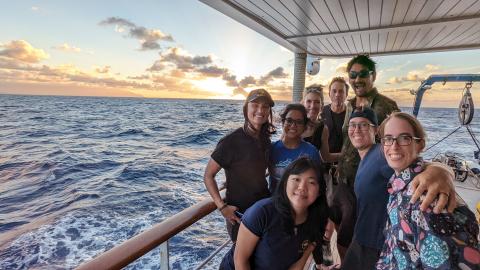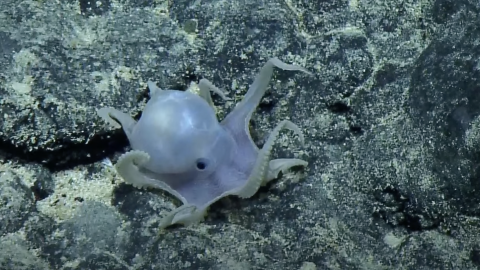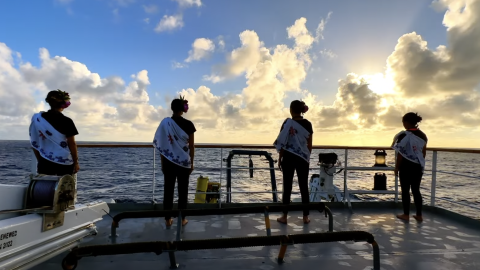Meet Ocean Explorer Sebastian Martinez
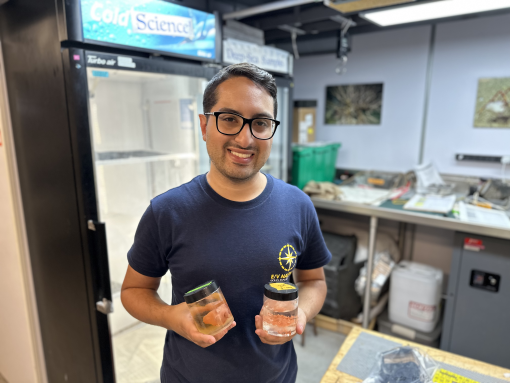
One of the signature parts of Nautilus expeditions is sailing with early career professionals on the ship providing workforce development opportunities and exposure to field-based exploration in the Science & Engineering Internship Program. Get to know Ala ʻAumoana Kai Uli’s Ocean Science Intern Sebastian Martinez in this Q&A blog. Sebastian is an undergraduate student at the University of Hawai‘i at Mānoa studying toward a Bachelor of Science in Marine Biology, a minor in Earth Science, a Geospatial Information Science certificate, and a certificate from the Marine Option Program.
Can you tell us a little about your background? What influenced you as a child?
I was raised in Des Moines, Washington, just south of Seattle on Puget Sound. Being in such close proximity to the sound, a lot of school field trips in elementary school would take place at our local beach parks during low tides. We would be given intertidal ID guides and free reign to explore as we pleased! Seeing a wide variety of unfamiliar interesting marine animals such as fast-moving sunflower stars, burrowing moon snails, and my favorite sighting, a juvenile Giant Pacific Octopus, served as a solid foundational interest in marine science in my early youth.
Another significant influence was reading non-fiction books from a young age. In 3rd grade, I read a book on the ancient coelacanth fish and immensely enjoying the story of the discovery of the first living coelacanth by Marjorie Courtenay-Latimer off the coast of the Comoro Islands. This contradicted popular knowledge at the time and Marjorie had to navigate how to preserve the specimen with minimal communication from experts. I was so interested in the story that I went to the local library and attempted to request a copy of the original rare book, Old Four Legs, with the field notes from this story. I never got my hands on the book, but the memories of learning about discoveries of new species living in the deep clearly stuck with me!
When you were a kid, what did you want to be when you grew up?
Growing up, I spent a significant amount of time watching nature documentaries, particularly programs like Blue Planet, where an omnipresent narrator would guide you through alien environments, showing the ocean world through a new lens. I gravitated towards this format of ocean education over more popular ocean programs like Shark Week, showing scientists conducting research in the field. At the time, I was unsure why I preferred one over the other, but looking back now as a fully-grown queer, mixed-race man with disabilities, I realize it is because even then I could not see myself in the scientists that media portrayed.
The drive to see myself as one of these professionals drove me to want to become a marine scientist from early elementary school, something I continue to pursue today. I’m passionate that more generations can see themselves doing science.
In pursuing this passion, I’ve proudly had over a decade of history with Ocean Exploration Trust helping me grow into my career goals. In 2013, I was fortunate to be selected to participate in OET’s former Honors Research Program - an immersive summer experience for high school students.
As part of the HRP program, I spent five weeks at the University of Rhode Island Graduate School of Oceanography, learning the basic principles of ocean exploration. The program culminated in my first experience at sea and on E/V Nautilus exploring the Mid-Cayman Rise and Von Damm hydrothermal vent field. This experience provided a strong motivation academically and was a big part of what led me ten years later to apply for the OET Science and Engineering Internship.
What would you consider to be your greatest challenge entering this field?
As an intersectional individual who is part of the BIPOC community, being Latino and Kurdish in descent, the LGBTQ+ community as an openly gay man, and the disabled community as a person with both Tourette’s Syndrome and Autism, I have faced many barriers that commonly prevent marginalized students from entering STEM fields. While the field is changing to become more aware and beginning to combat these barriers - in my own academic journey I encountered challenges beginning in primary and secondary education.
When I was younger, the symptoms of my learning disabilities were more severe, with my tics (involuntary body movements and sounds) glaringly apparent. Although these would slowly mellow as I aged, the public education system often assumes that the severity of your disability is unchanging and from the point of diagnosis. This assessment determines your professional viability for the rest of your life. This inflexibility resulted in me having to take many special needs courses that largely I did not need which in cases like mathematics, set me back compared to peers without disabilities, amplifying the disadvantage when applying to colleges for a STEM degree.
As a person with disabilities, there are two major challenges I've encountered that highly impacted my path: access to necessary accommodations and the complex social decision of when/if to disclose my disability in different settings.
One of the compounding issues for students with disabilities entering college is the transfer of responsibility and administrative burden to register with their university’s disability department to receive accommodations, an automatic process in K-12 public school systems. This leaves the responsibility with the student, often requiring persistent self-advocacy for their disabilities, which can be difficult to contend with personally and socially as young people. From personal experience, during my first semester, I struggled with advocating my disabilities due to the attached stigma which delayed receiving needed accommodations and my grades took the impact. This significantly impacted my GPA. It took me years of high marks to climb back above a 3.0 GPA after one bad semester of grades.
Outside the classroom, challenges also arise when students with disabilities seek out research positions and field experiences. In the decision to disclose disabilities the timing of disclosure can be key. If you disclose your disability too early, you risk triggering potential bias in potential mentors, whether they are aware of it or not, which can have long-lasting implications on the partnership. On the other hand, disclosing late risks leaving mentors ill-prepared to accommodate disabilities and, in some cases, students in problematic situations without support.
In the application process disclosing your disability status in a personal statement subjects it to further unconscious or conscious bias from hiring faculty and committees. Within text-limited applications, there is a burden placed on students with disability status to justify aberrations in the “traditional” academic journey that can be attributed to their disabilities, taking up a significant portion of their statements that otherwise would be committed to showcasing their interests and identity as competent and curious scientists. Yet, disability is a key part of many people’s identity so failure to disclose inhibits the ways students can show their ingenuity, problem-solving skills, and persistence.
The Centers for Disease Control reports that over one in four adults (>25%) in the United States have some type of disability. However, today only approximately 9% of people earning Ph.D. graduate degrees report having a disability. Although there are difficulties and barriers, many of these can be overcome with greater community advocacy, support, empathy, and learning. This opens up learning about our ocean to those with all experiences including disabilities and nontraditional academic pathways.
So far, I’m proud to have overcome many of these barriers on my academic path so far. While my hard work allowed me to pursue this career path, I hope that others following in my path don’t need to struggle over the same obstacles to reach their goals. I hope to serve as a role model for underrepresented communities and actively work to uplift those in similar scenarios through public outreach, mentoring students, and helping shape the future of academia to include those of all backgrounds and experiences.
Do you have any advice for someone looking to follow a similar path?
I do! For fellow members of the disability community, my advice is that you can persevere and be successful in the scientific community with hard work, creative thinking, and undying curiosity regardless if the road can be rough, with moments that can be demoralizing! By showing up fully as yourself, you lay the brickwork for later generations of inspired members of our community to walk a paved path to scientific exploration. You can do it!
What's next for your ocean studies and career?
Currently, I am working on my undergraduate thesis project with the University of Hawaiʻi at Mānoa’s Deep-Sea Fish Ecology Lab. My research focuses on guyots (flat-topped seamounts) within the Pacific Remote Islands Marine National Monument around Wake Atoll. I am working to produce a seafloor habitat classification system that integrates biological and geological observations, multibeam maps, backscatter readings, and sub-bottom profiler data to predict habitat types on these unexplored guyots. There is so much we still need to learn about the ocean, hopefully, this system could help build inferences about habitats based on the guyot shape, structure, and hardness.
Ahead I am also working on applications for graduate school and funding to continue my academic journey. Ideally, I will work on a graduate thesis project that weaves together my interdisciplinary interests in marine biology and geology using geospatial technologies and analyses in deep-sea environments.
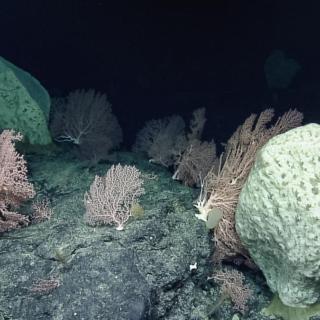
Ala ʻAumoana Kai Uli in Papahānaumokuākea Marine National Monument
Ocean Exploration Trust and partners will conduct a telepresence-enabled expedition to explore unseen deep-sea habitats aboard E/V Nautilus with ROV and seafloor mapping operations in the Papahānaumokuākea Marine National Monument (PMNM) focused on the largely unexplored northwestern section of the Monument.
